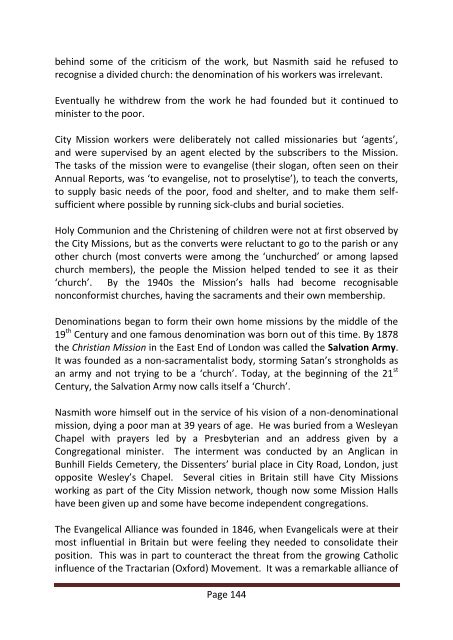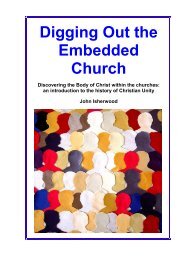Christian Unity (the book) - The Maranatha Community
Christian Unity (the book) - The Maranatha Community
Christian Unity (the book) - The Maranatha Community
Create successful ePaper yourself
Turn your PDF publications into a flip-book with our unique Google optimized e-Paper software.
ehind some of <strong>the</strong> criticism of <strong>the</strong> work, but Nasmith said he refused torecognise a divided church: <strong>the</strong> denomination of his workers was irrelevant.Eventually he withdrew from <strong>the</strong> work he had founded but it continued tominister to <strong>the</strong> poor.City Mission workers were deliberately not called missionaries but ‘agents’,and were supervised by an agent elected by <strong>the</strong> subscribers to <strong>the</strong> Mission.<strong>The</strong> tasks of <strong>the</strong> mission were to evangelise (<strong>the</strong>ir slogan, often seen on <strong>the</strong>irAnnual Reports, was ‘to evangelise, not to proselytise’), to teach <strong>the</strong> converts,to supply basic needs of <strong>the</strong> poor, food and shelter, and to make <strong>the</strong>m selfsufficientwhere possible by running sick-clubs and burial societies.Holy Communion and <strong>the</strong> Christening of children were not at first observed by<strong>the</strong> City Missions, but as <strong>the</strong> converts were reluctant to go to <strong>the</strong> parish or anyo<strong>the</strong>r church (most converts were among <strong>the</strong> ‘unchurched’ or among lapsedchurch members), <strong>the</strong> people <strong>the</strong> Mission helped tended to see it as <strong>the</strong>ir‘church’. By <strong>the</strong> 1940s <strong>the</strong> Mission’s halls had become recognisablenonconformist churches, having <strong>the</strong> sacraments and <strong>the</strong>ir own membership.Denominations began to form <strong>the</strong>ir own home missions by <strong>the</strong> middle of <strong>the</strong>19 th Century and one famous denomination was born out of this time. By 1878<strong>the</strong> <strong>Christian</strong> Mission in <strong>the</strong> East End of London was called <strong>the</strong> Salvation Army.It was founded as a non-sacramentalist body, storming Satan’s strongholds asan army and not trying to be a ‘church’. Today, at <strong>the</strong> beginning of <strong>the</strong> 21 stCentury, <strong>the</strong> Salvation Army now calls itself a ‘Church’.Nasmith wore himself out in <strong>the</strong> service of his vision of a non-denominationalmission, dying a poor man at 39 years of age. He was buried from a WesleyanChapel with prayers led by a Presbyterian and an address given by aCongregational minister. <strong>The</strong> interment was conducted by an Anglican inBunhill Fields Cemetery, <strong>the</strong> Dissenters’ burial place in City Road, London, justopposite Wesley’s Chapel. Several cities in Britain still have City Missionsworking as part of <strong>the</strong> City Mission network, though now some Mission Hallshave been given up and some have become independent congregations.<strong>The</strong> Evangelical Alliance was founded in 1846, when Evangelicals were at <strong>the</strong>irmost influential in Britain but were feeling <strong>the</strong>y needed to consolidate <strong>the</strong>irposition. This was in part to counteract <strong>the</strong> threat from <strong>the</strong> growing Catholicinfluence of <strong>the</strong> Tractarian (Oxford) Movement. It was a remarkable alliance ofPage 144








